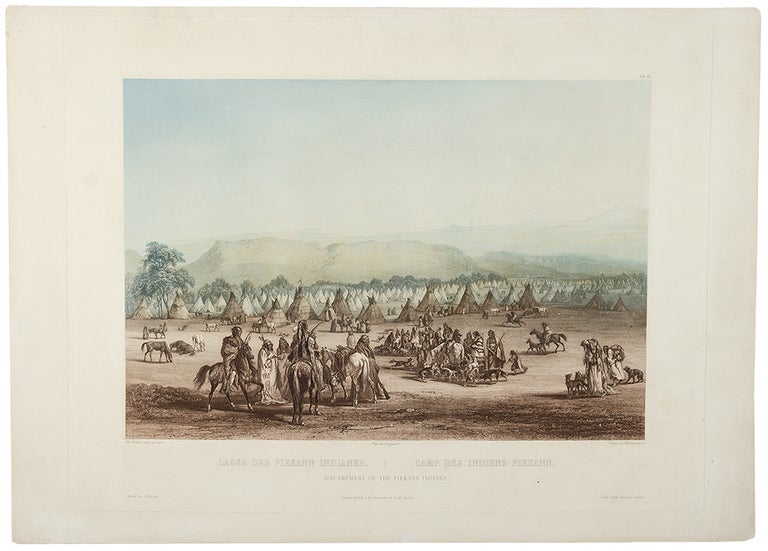BODMER, Karl (1809-1893)
Encampment of the Piekann Indians
[Tab. 43] Paris, Coblentz and London: [1839-1842]. Colour-printed aquatint engraving by Beyer and Hürlimann after Bodmer. Expert repairs to margins, not affecting image area. Sheet size: 17 1/4 x 24 1/8 inches.
Prince Maximilian and his party arrived at Fort McKenzie on 9 August 1833. The present plate illustrates the Piegan Blackfoot camp near to Fort McKenzie with dozens of Indians, dogs and horses in the foreground giving an impression of the noisy bustle of camp life. A typical feature of Bodmer's work is the careful attention to detail, and this can be seen here in the varying sizes of the tipis, a fact that many artists would have missed: the size of tipi was a reflection of variation in family sizes and their wealth. The Piegan Blackfoot, a subgroup of the Blackfoot tribe, were the archetypal Plains Indians, for whom the buffalo provided nearly all their needs, from clothing to food to leather for their tipis. Because of this dependence on the buffalo, the Blackfoot were swift to adapt to the use of horses and soon had large herds and a well-deserved reputation for horsemanship. When they obtained firearms they became particularly potent raiders and were in effect masters of the North Plains. They are shown here at the height of their power. Karl Bodmer's images show great versatility and technical virtuosity and give us a uniquely accomplished and detailed picture of a previously little understood (and soon to vanish) way of life. Swiss-born Bodmer was engaged by Prince Maximilian zu Wied-Neuwied (1782-1867) specifically to provide a record of his travels in North America, principally among the Plains Indians. In the company of David Dreidoppel (Prince Maximilian's servant and hunting companion), their travels in North America were to last from 1832 to 1834. Well-armed with information and advice, the party finally left St.Louis, on the most important stage of their travels, aboard the steamer Yellow Stone on April 10 1833. They proceeded up the treacherous Missouri River along the line of forts established by the American Fur Company. At Bellevue they encountered their first Indians, then went on to make contact with the Sioux tribe, learning of and recording their little known ceremonial dances and powerful pride and dignity. Transferring from the Yellow Stone to another steamer, the Assiniboin, they continued to Fort Clark, visiting there the Mandan, Mintari and Crow tribes, then the Assiniboins at Fort Union, the main base of the American Fur Company. On a necessarily much smaller vessel they journeyed through the extraordinary geological scenery of that section of the Missouri to Fort Mackenzie in Montana, establishing a cautious friendship with the fearsome Blackfeet. From this, the westernmost point reached, it was considered too dangerous to continue and the return journey downstream began. The winter brought its own difficulties and discomforts, but Bodmer was still able to execute numerous studies of villages, dances and especially the people, who were often both intrigued and delighted by his work. The portraits are particularly notable for their capturing of individual personalities, as well as forming a primary account of what was to become virtually lost cultures.
Graff 4648; Howes M443a; Pilling 2521; Sabin 47014; Wagner-Camp 76:1.
Item #28451
Price: $2,500.00


